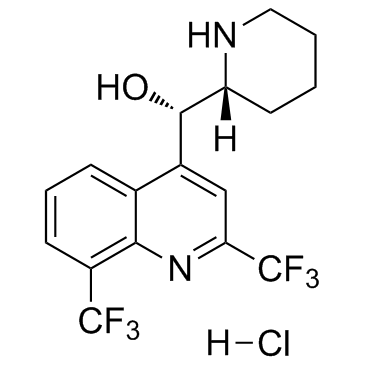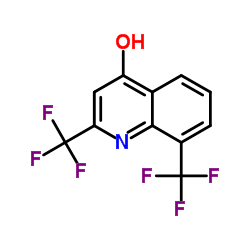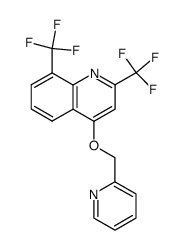Mefloquine hydrochloride

Mefloquine hydrochloride structure
|
Common Name | Mefloquine hydrochloride | ||
|---|---|---|---|---|
| CAS Number | 51773-92-3 | Molecular Weight | 378.312 | |
| Density | 1.4±0.1 g/cm3 | Boiling Point | 415.7±40.0 °C at 760 mmHg | |
| Molecular Formula | C17H17ClF6N2O | Melting Point | 250-254ºC | |
| MSDS | Chinese USA | Flash Point | 205.2±27.3 °C | |
| Symbol |

GHS07 |
Signal Word | Warning | |
Use of Mefloquine hydrochlorideMefloquine hydrochloride is a quinoline antimalarial drug that is structurally related to the antiarrhythmic agent quinidine. IC50 Value: 1 microM ( for K+ channel) [1]Target: AntiparasiticMefloquine is widely used in both the treatment and prophylaxis of Plasmodium falciparum malaria. MQ can induces oxidative stress in vitro. Evidence indicates that reactive oxygen species (ROS) may be used as a therapeutic modality to kill cancer cells [2].in vitro: Mefloquine inhibitedKvLQT1/minK channel currents with an IC50 value of approximately 1 microM. Mefloquine slowed the activation rate of KvLQT1/minK and more block was evident at lower membrane potentials compared with higher ones. HERG channel currents were about 6-fold less sensitive to block by mefloquine (IC50 = 5.6 microM). Block of HERG displayed a positive voltage dependence with maximal inhibition obtained at more depolarized potentials [1]. MQ has a highly selective cytotoxicity that inhibits PCa cell growth. MQ-mediated ROS simultaneously downregulated Akt phosphorylation and activated extracellular signal-regulated kinase (ERK), c-Jun N-terminal kinase (JNK) and adenosine monophosphate-activated protein kinase (AMPK) signaling in PC3 cells [2]. in vivo: Pregnant rats were treated orally with AS (15 and 40 mg/kg body weight (bwt)/day), MQ (30 and 80 mg/kg bwt/day) and AS/MQ (15/30 and 40/80 mg/kg bwt/day) on days 9-11 post coitum (pc). The dams were euthanized on day 12 pc and gestational and embryos histological parameters were evaluated [3].Clinical trial: Activity of Mefloquine Against Urinary Schistosomiasis . Phase 2 |
| Name | Mefloquine Hydrochloride |
|---|---|
| Synonym | More Synonyms |
| Description | Mefloquine hydrochloride is a quinoline antimalarial drug that is structurally related to the antiarrhythmic agent quinidine. IC50 Value: 1 microM ( for K+ channel) [1]Target: AntiparasiticMefloquine is widely used in both the treatment and prophylaxis of Plasmodium falciparum malaria. MQ can induces oxidative stress in vitro. Evidence indicates that reactive oxygen species (ROS) may be used as a therapeutic modality to kill cancer cells [2].in vitro: Mefloquine inhibitedKvLQT1/minK channel currents with an IC50 value of approximately 1 microM. Mefloquine slowed the activation rate of KvLQT1/minK and more block was evident at lower membrane potentials compared with higher ones. HERG channel currents were about 6-fold less sensitive to block by mefloquine (IC50 = 5.6 microM). Block of HERG displayed a positive voltage dependence with maximal inhibition obtained at more depolarized potentials [1]. MQ has a highly selective cytotoxicity that inhibits PCa cell growth. MQ-mediated ROS simultaneously downregulated Akt phosphorylation and activated extracellular signal-regulated kinase (ERK), c-Jun N-terminal kinase (JNK) and adenosine monophosphate-activated protein kinase (AMPK) signaling in PC3 cells [2]. in vivo: Pregnant rats were treated orally with AS (15 and 40 mg/kg body weight (bwt)/day), MQ (30 and 80 mg/kg bwt/day) and AS/MQ (15/30 and 40/80 mg/kg bwt/day) on days 9-11 post coitum (pc). The dams were euthanized on day 12 pc and gestational and embryos histological parameters were evaluated [3].Clinical trial: Activity of Mefloquine Against Urinary Schistosomiasis . Phase 2 |
|---|---|
| Related Catalog | |
| References |
| Density | 1.4±0.1 g/cm3 |
|---|---|
| Boiling Point | 415.7±40.0 °C at 760 mmHg |
| Melting Point | 250-254ºC |
| Molecular Formula | C17H17ClF6N2O |
| Molecular Weight | 378.312 |
| Flash Point | 205.2±27.3 °C |
| Exact Mass | 378.116669 |
| PSA | 45.15000 |
| LogP | 2.87 |
| Vapour Pressure | 0.0±1.0 mmHg at 25°C |
| Index of Refraction | 1.519 |
| Storage condition | Refrigerator |
| Water Solubility | DMSO: 38 mg/mL, soluble |
CHEMICAL IDENTIFICATION
HEALTH HAZARD DATAACUTE TOXICITY DATA
|
| Symbol |

GHS07 |
|---|---|
| Signal Word | Warning |
| Hazard Statements | H302 |
| Precautionary Statements | P301 + P312 + P330 |
| Personal Protective Equipment | dust mask type N95 (US);Eyeshields;Gloves |
| Hazard Codes | Xn: Harmful; |
| Risk Phrases | R22 |
| RIDADR | UN 3077 9 / PGIII |
| WGK Germany | 3 |
| RTECS | VC0308000 |
|
~81% 
Mefloquine hydr... CAS#:51773-92-3 |
| Literature: Adam Tetrahedron, 1989 , vol. 45, # 5 p. 1409 - 1414 |
|
~% 
Mefloquine hydr... CAS#:51773-92-3 |
| Literature: Adam Tetrahedron, 1989 , vol. 45, # 5 p. 1409 - 1414 |
|
~% 
Mefloquine hydr... CAS#:51773-92-3 |
| Literature: Adam Tetrahedron, 1989 , vol. 45, # 5 p. 1409 - 1414 |
|
~% 
Mefloquine hydr... CAS#:51773-92-3 |
| Literature: Adam Tetrahedron, 1989 , vol. 45, # 5 p. 1409 - 1414 |
|
~% 
Mefloquine hydr... CAS#:51773-92-3 |
| Literature: Adam Tetrahedron, 1989 , vol. 45, # 5 p. 1409 - 1414 |
|
~% 
Mefloquine hydr... CAS#:51773-92-3 |
| Literature: Adam Tetrahedron, 1989 , vol. 45, # 5 p. 1409 - 1414 |
|
Preliminary investigation of the contribution of CYP2A6, CYP2B6, and UGT1A9 polymorphisms on artesunate-mefloquine treatment response in Burmese patients with Plasmodium falciparum malaria.
Am. J. Trop. Med. Hyg. 91(2) , 361-6, (2014) CYP2A6, CYP2B6, and UGT1A9 genetic polymorphisms and treatment response after a three-day course of artesunate-mefloquine was investigated in 71 Burmese patients with uncomplicated Plasmodium falcipar... |
|
|
Studying the effect of chloroquine on sporozoite-induced protection and immune responses in Plasmodium berghei malaria.
Malaria Journal 14 , 130, (2015) Sporozoite immunization of animals and humans under a chemo-prophylactic cover of chloroquine (CPS-CQ) efficiently induces sterile protection against malaria. In humans, CPS-CQ is strikingly more effi... |
|
|
Comparison between Flow Cytometry, Microscopy, and Lactate Dehydrogenase-Based Enzyme-Linked Immunosorbent Assay for Plasmodium falciparum Drug Susceptibility Testing under Field Conditions.
J. Clin. Microbiol. 53 , 3296-303, (2015) Flow cytometry is an objective method for conducting in vitro antimalarial sensitivity assays with increasing potential for application in field sites. We examined in vitro susceptibility to seven ant... |
| Mefloquine hydrochloride |
| [2,8-bis(trifluoromethyl)quinolin-4-yl]-(2-piperidyl)methanol |
| EINECS 257-412-0 |
| [2,8-bis(trifluoromethyl)quinolin-4-yl](piperidin-2-yl)methanol |
| 4-quinolinemethanol, a-2-piperidinyl-2,8-bis(trifluoromethyl)- |
| [2,8-Bis(trifluoromethyl)-4-quinolinyl](2-piperidinyl)methanol |
| MFCD00797519 |
| (AS)-rel-a-(2R)-2-Piperidinyl-2,8-bis(trifluoromethyl)-4-quinolinemethanol monohydrochloride |
| 4-Quinolinemethanol, α-2-piperidinyl-2,8-bis(trifluoromethyl)- |
| α-2-Piperidinyl-2,8-bis(trifluoromethyl)-4-quinolinemethanol |
| Mefloquine (hydrochloride) |
![bis[2,8-di(trifluoromethyl)quinolin-4-yl-2-pyridyl] ketone structure](https://image.chemsrc.com/caspic/345/35853-55-5.png)



![4-[(tert-butyldimethylsilyl)(2-pyridyl)methoxy]-2,8-bis(trifluoromethyl)quinoline structure](https://image.chemsrc.com/caspic/003/123590-69-2.png)


